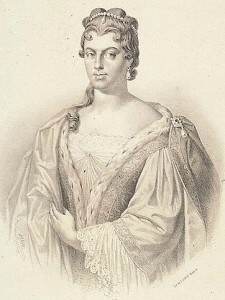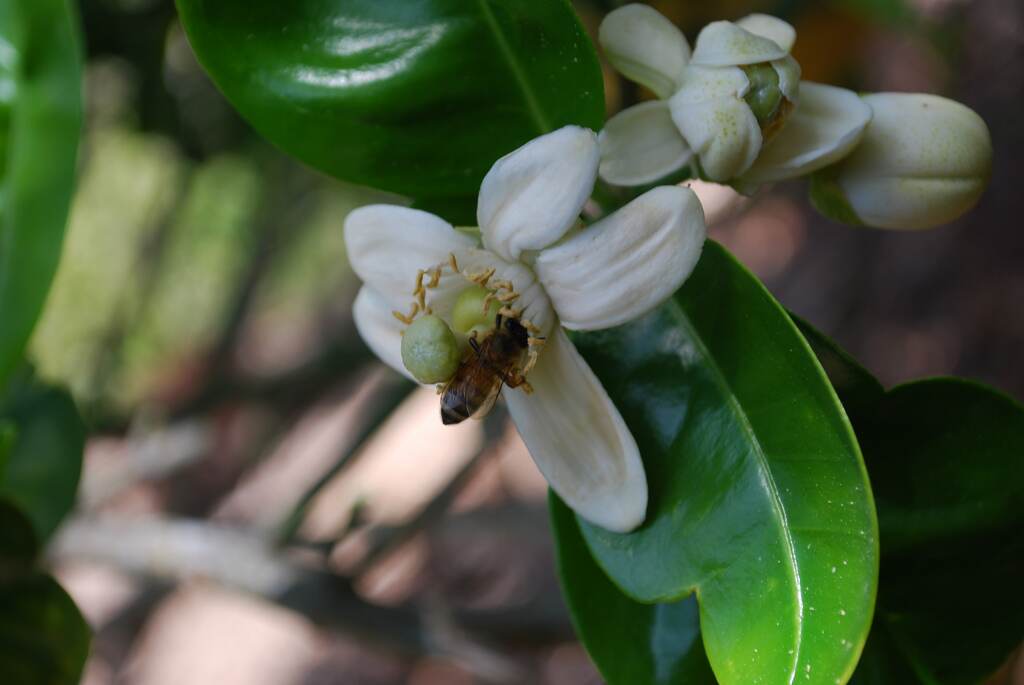Today’s featured essential oil is exotic, romantic and heady.
Essential Oil of Neroli
(Citrus aurantium var. amara)

This oil was named for Anne-Marie de la Tremoille, Princess of Nerola, Italy.
The Princess used the oil to scent her hair, bathwater and even her gloves.
It is still an important ingredient in high end perfumes today.
 Orange Flowers and Weddings
Orange Flowers and Weddings
The first time I heard of the orange blossom was 1985 when I was living in Rome, Italy. I had been dating a beautiful Italian man by the name of Michele Pezzuti. An Italian girlfriend was teasing me one day and said in a sing song voice, “si sente il fiore d’arancio nel’aria” (the smell of orange blossoms is in the air). I had no idea what she was talking about. I understood the words, but not the meaning. I soon learned that orange flowers are associated with marriage in Italy, and are often used in the bride’s bouquet and featured prominently during the wedding. I can’t help seeing a bit of humorous irony in the fact that Neroli is also one of the best oils to use during times of shock.
Synonyms: orange flower, orange blossom, neroli bigarade
Plant Part: The essential oil is obtained by steam distillation from the freshly picked flowers of the bitter orange tree. A Neroli hydrosol is produced as a by-product of the distillation process.
Oil Characteristics: The essential oil of Neroli can range in color from pale yellow to amber. Her aroma is sweetly exotic and sensual.
Note: Middle
Chemical Families: Monoterpenes, Monoterpenols
Therapeutic Properties:
- Wonderful at helping alleviate depression
- Skin Nourishing
- Cicatrisant
- Cooling
- CNS sedative
Applications
- In any products designed for skin healing and rrejuvenation
- Add to any blend for an anti-anxiety and/or antidepressant effect.
- Diffuser: to deodorize and fill the air with fragrance.
Safety: Non-toxic, non-irritating.
Blends well with: All citruses, floral notes and base notes. Note: Neroli is a strong oil and you only need to use a small amount or it may overpower your blend.
A Recipe Using Neroli:
(This blend is found on pg 68 of the Ebook Essential Living Aromatherapy Recipes)
Exotic Diffuser Blend
Ingredients:
2 drops Ylang Ylang essential oil
1 drop Neroli essential oil
3 drops Patchouli essential oil
Directions:
Add the oils to your favorite diffuser and enjoy.
 Subtle Properties: (vibrational and energetic): Neroli corresponds with our Sacral Chakra, the center of creation, passion, optimism, pleasure. When this chakra is depleted, you may begin to feel depressed and notice your creativity is blocked. All aspects of the Goddess reign here, so it makes sense it is the seat of a woman’s power. If you’re reading this and you’re a woman with extra weight over the sacral area, I invite you to look deeper inside yourself to see what part of your power you may be covering or protecting.
Subtle Properties: (vibrational and energetic): Neroli corresponds with our Sacral Chakra, the center of creation, passion, optimism, pleasure. When this chakra is depleted, you may begin to feel depressed and notice your creativity is blocked. All aspects of the Goddess reign here, so it makes sense it is the seat of a woman’s power. If you’re reading this and you’re a woman with extra weight over the sacral area, I invite you to look deeper inside yourself to see what part of your power you may be covering or protecting.
The source of this beautiful image is On a Journey Back to Her Wings, blog by Amy Riddle
Who Are You?
I am one who embraces your romantic nature
I am one who opens your heart to peace
I am one who caresses your nerves and stills the mental tornado
References
1. Battaglia S. The Complete Guide to Aromatherapy. 2nd edition, The International Centre of Holistic Aromatherapy, Australia, 2003
2. Davis P. Aromatherapy an A-Z. New revised edition C.W. Daniel Company Limited, England, 1999
3. Keville, K. Aromatherapy, A Complete Guide to the Healing Art, The Crossing press, USA, 1995
4. Mojay G. Aromatherapy for Healing the Spirit, Henry Holt and Company Inc., England, 1996
5. Price S. Aromatherapy for Health Professionals, 2nd edition, Churchill Livingstone, 1999
6. Tisserand R. The Art of Aromatherapy, Healing Arts Press, USA, 1977







Mmm. Neroli. Thank you for including the subtle properties of the oil. I will definitely need to meditate on what I’m covering up or protecting!
Stephanie, you don’t know how many times I’ve said the same thing 🙂
Hi, I’m from Montreal, Quebec, this is my 1st posting, and I hope you don’t mind a question that concerns a different floral EO. Actually, this concerns “Grade” known as “Extra”, (which I had assumed was synonymous with “1st extraction”). But I got a bottle of Ylang ylang (Cananga odorata genuina) origin: Madagascar, labeled “Grade: Extra” Chemotype: germacrene D, benzyl acetate & B caryophyllene. –Yet on the SAME label it reads: “3rd Extraction”. But how can that be “Extra”, then? Or maybe I’m confused between “fraction” and “extraction”… ? Now, I’m not sure if my Ylang ylang is any good for therapeutic purposes, or just good as a scent for soap. I tried googling the question in various wordings, skimmed through a number of articles, etc., but still can’t figure out the answer. I hope this is a useful question. In any case, many thanks for the loads of useful information and insight that you’ve ALREADY provided on your site, by the way.